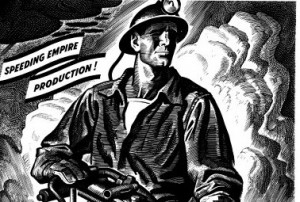BY Stan Sudol
The German invasion of Poland was to have dramatic effects on Sudbury. Many communities across Canada, Britain and the United States played exceptional roles in producing certain commodities and munitions for the war effort. However, it would be no exaggeration to say that in North America, Sudbury was among the top few communities that were absolutely critical to the war effort. The International Nickel Company of Canada, as it was known back then, and its employees in Sudbury would go on to supply an astonishing 95 percent of all Allied demands for nickel – a vital raw material and a foundation metal absolutely essential for the Allies’ final victory.
Nickel’s unique properties include a combination of strength, hardness, ductility, resistance to corrosion and the ability to maintain strength under high heat. It can transfer these properties to other metals making nickel a critical component for a wide variety of civilian and military products.
World War Two was a mechanized war that utilized more technically advanced equipment than ever before. To win, the Allied armies needed guns, tanks, planes, battleships and a host of other weaponry that could only be made from hardened nickel-steels and other nickel-alloys.
Nickel hardened armor plate for tanks, nickel alloys for anti-aircraft guns and ordinance and even lightweight, tough portable bridges used in the invasion of Germany all required this essential metal.
“Given the chance, Hitler would willingly have traded the whole Silesian Basin, and thrown in Hermann Goering and Dr. Goebbels to boot, for a year’s possession of the Sudbury Basin,” Maclean’s journalist James H. Gray aptly wrote in an October 1, 1947 article on the city.
The price of nickel was under government control. From 1929 to 1941 nickel sold for 35 cents a pound. For the remainder of the war it was reduced to 31 ½ cents per pound. By contrast, the metal cost between 40 and 55 cents a pound during World War One.
On a visit to Sudbury to promote the victory loan campaign in February 1942, the C.D. Howe, Canada’s famous minister of munitions and supplies, said, “Those of you who live in Sudbury and are employed by one of your nickel companies need not feel that you are not taking part in this war. … But I can say this, that if anything should happen to interrupt the production of nickel in the city of Sudbury, the whole character of the war will be changed. I know of no important munition of war that doesn’t have a nickel content.”
The other main reason for the visit was to ensure labour relations were harmonious.
Labour shortages were a constant struggle during the war years. Hardrock miners from Kirkland Lake, Timmins and Sudbury who enlisted in the armed forces were in high demand for their expertise working with explosives – an integral part of the mining process. Canadian miners were used to blast tunnels and excavations in the Rock of Gibraltor to house medical facilities, repair shops, storage areas and defensive works. In the early fifties, Sudbury miners helped Toronto build its first subway tunnel.
In October 1941, wages were frozen by the federal government, the union leadership were discouraging strikes and many factory employees were routinely putting in 48 to 56 and even 64 hours per week.
The following March, the federal government established the National Selective Service (NSS) within the Department of Labour to help deal with the severe labour shortages throughout the entire economy due to the rapid expansion of war related industries and military demands on manpower. The first industry identified as an essential occupation was the nickel industry.
Workers could not leave the employ of Inco or Falconbridge without the permission of a National Selective Services Officer. Hard-rock mining in the 1940s was a tough, dirty and dangerous job.
Nickel workers in 1943 laboured for 56 hours a week with no overtime pay. They earned 51 cents an hour for surface work, 61 cents for underground labour while miners made 71 cents and first-class trades earned 78 cents an hour. There were no fringe benefits except a one week paid vacation.
Regardless of government regulation many men did leave for less strenuous jobs in southern Ontario that were also desperately short of workers.
Appealing to the miners desire for better working conditions and wages, a strong and determined organizing campaign resulted in Local 598 of the Mine Mill and Smelter workers becoming the collective bargaining agents for Inco and Falconbridge in 1944.
Ultimately it was war time: labour shortages, high taxes, wage controls and supportive provincial legislation – original federal laws were too weak and stronger legislation only came in after the certification – that allowed the union to finally become established in the Sudbury Basin. Sudbury was one of the least unionized cities in Canada at the start of the war and by 1950 the city had the largest organized workforce in the country who were among the hig






Comments are closed.